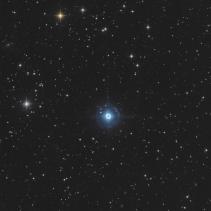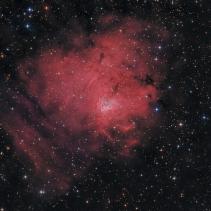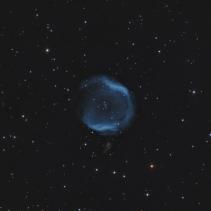Nebulas
NGC 281
NGC 281, IC 11 or Sh2-184 is a bright emission nebula and part of an H II region in the northern constellation of Cassiopeia and is part of the Milky Way's Perseus Spiral Arm. This 20×30 arcmin sized nebulosity is also associated with open cluster IC 1590, several Bok globules and the multiple star, B 1. It collectively forms Sh2-184, spanning over a larger area of 40 arcmin.
Colloquially, NGC 281 is also known as the Pacman Nebula for its resemblance to the video game character.
E. E. Barnard discovered this nebula in August 1883, who described it as "a large faint nebula, very diffuse." Multiple star 'B 1' or β 1 was later discovered by S. W. Burnham, whose bright component is identified as the highly luminous O6 spectral class star, HD 5005 or HIP 4121. It consists of an 8th-magnitude primary with four companions at distances between 1.4 and 15.7 arcsec. There has been no appreciable change in this quintuple system since the first measures were made in 1875.
L = 13 * 1800 sec. bin1, R = 9 * 900 сек. bin2, G = 9 * 1000 сек. bin2, B = 9 * 1100 сек. bin2, Ha = 26 * 1800 сек. bin2.
Total exposition - 27 hours
Pixinsight 1.8 and Photoshop.
NGC 7662
NGC 7662, also known as the Blue Snowball Nebula or Snowball Nebula, is a planetary nebula located in the constellation Andromeda.
The distance to this nebula is not known with any real accuracy. According to the Skalnate Pleso Catalogue (1951) the distance of NGC 7662 is about 1,800 light years, the actual diameter about 20,000 AU. In a more recent survey of the brighter planetaries, C.R.O'Dell (1963) derived a distance of 1,740 parsecs or about 5,600 light years, increasing the actual size to 0.8 light year, or nearly 50,000 AU. It has a faint central star that is variable, with a magnitude range of 12 to 16. The central star is a bluish dwarf with a continuous spectrum and a computed temperature of about 75,000K. The nuclei of the planetary nebulae are among the hottest stars known.
Ha = 20 * 1800 sec. bin1, OIII = 10 * 1800 sec. bin1, OIII = 20 * 900 sec. bin1.
Total exposition is 20 hours.
Pixinsight 1.8 and Photoshop.
NGC 1491
NGC 1491 is a bright nebula in the constellation of Perseus. It is also known as LBN 704.
NGC 1491 (also listed in the Sharpless Catalog as SH2-206) is an emission nebula, which means it is a cloud of ionized hydrogen gas and a stellar nursery. The nebula is primarily illuminated by the bright star near the center of this image. This star is not only the primary source of the ultraviolet radiation that is lighting up the nebula, it is also generating an energetic stellar wind that is eroding away the gas of the nebula. At the brightest region of this image near that star, a subtle "bubble" might be seen near that star.
L = 16 * 1800 sec. bin1, RGB = 8 * 1200 sec. bin2, Ha = 26 * 1800 sec. bin2, Ha = 8 * 1800 sec.in the each filters.
Total exposition - 33 hours.
Pixinsight 1.8, Photoshop, eXcalibrator.
PK 104-29.1 (Jones 1)
Jones 1 (PK 104-29.1) is a planetary nebula in Pegasus.
Ha = 11 * 3600 sec. bin1, OIII = 10 * 3600 sec. bin1.
Total exposition is 21 hours.
Pixinsight 1.8 and Photoshop.




